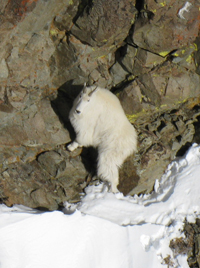The scattered herds of agile mountain goats that tread where few others dare in the highest reaches of the Wood River Valley appear to be maintaining their numbers. A recent aerial survey by the Idaho Department of Fish and Game in the Smoky and Boulder mountain ranges suggests the number of goats there may even be increasing slightly.
The survey, flown over the agency's big game management Unit 48 in early 2009, counted 83 goats. Unit 48 covers both sides of the Wood River Valley above Ketchum, taking in the western and easternmost sides of the Smoky and Boulder mountains, respectively.
"That's right in there with what we would expect to see," said Regan Berkley, Fish and Game's Magic Valley regional wildlife biologist. "It didn't send up any red flags for us."
Fish and Game objectives for Unit 48 are to find 70 to 90 mountain goats inhabiting this rugged patch of real estate. Berkley said the surveys, which are conducted about every five years, do not account for every single mountain goat that inhabits the rough backcountry area.
The agency's previous survey of Unit 48 in 2004 found 79 goats.
Fish and Game biologists prefer to count mountain goats—whose billowy, pure-white coats allow them to blend into their snowy surroundings—during the heart of winter. They do this because of their ability to fly low in slow-moving helicopters to spot tracks in the snow. Once they spot hoof prints in the high-elevation snowpack, the biologists know goats must be nearby, said Berkley.
"There's pretty much nothing else up there at that time," she said.
Mountain goats are able to survive in these harsh alpine environments by clinging to steep mountainsides that shed snow and on exposed ridges that remain snow-free due to frequent winds. Goats scour the rocky terrain for scattered alpine grasses, sedges, lichens and trees or shrubs.
Weighing between 150 to 300 pounds, mountain goats have short, powerful legs with large hooves that make them sure-footed and agile. Both male and female goats have short, black horns. Young mountain goats are called "kids."
According to Fish and Game, fierce winters take the greatest toll on these champion mountain climbers—about eight out of 10 kids die in the cold temperatures of winter. Avalanches also pose a significant threat.
Fish and Game allows a limited hunt on goats in Idaho. The animals also occupy high-elevation areas in Hells Canyon and in the Salmon, Clearwater and Bitterroot ranges.
An aerial survey taken of mountain goat habitat in the White Cloud Mountains in 2002 raised alarm among state and federal officials. After years of holding steady at about 200 goats, the count found just 104 animals.
<
Speculation immediately centered on the prospect that winter recreationists could be impacting the goat population in the White Clouds. Fish and Game followed up with another survey in the White Clouds in 2004. Surprisingly, that count found 208 goats.
Fish and Game now attributes the discrepancy to abnormally hard, mid-winter snow conditions in 2002 that forced much of the herd down to lower elevations in search of greening food sources.
"We missed a whole bunch," said Tom Keegan, Fish and Game's wildlife manager for the Salmon Region, which covers the White Clouds. "The numbers were way back up where they should have been."
Another aerial survey taken in 2008 in the White Clouds found 194 goats, right about where Fish and Game wants them.
In the White Clouds, mountain goats occupy both sides of the main north-south divide. The herd, joined by the nearby goat populations in the Boulder and Pioneer mountains, is one of the southernmost populations of native mountain goats.
"It's a core population for us," Keegan said.
Mountain goats in Utah and Colorado were introduced by state wildlife officials.
Despite the good news indicating stable goat populations in local ranges, wildlife biologists with Fish and Game and the Sawtooth National Recreation Area continue to keep a close watch on the potential impacts that backcountry winter recreationists may be having on these nimble mountain dwellers.
"There are still a lot of questions about the impacts winter recreation may have," Berkley said.
These concerns have led SNRA officials to prohibit heli-ski operators from flying in certain high-elevation spots in the region where goats winter. The closures, which have been in place since the 1980s, extend across much of the high crests of the Boulder and Smoky mountains, said Robin Garwood, wildlife biologist with the SNRA.
The SNRA also places signs out indicating voluntary closures on short cliff bands in the Fourth of July Creek area in the western White Clouds and above Alturas Lake in the Sawtooth Mountains. Garwood said winter recreationists have largely respected those closures.
Since goats are sensitive to intrusions into their limited winter habitat, the presence of humans can force them into deep snow, sapping much-needed energy.
"They're pretty confined to their winter range," Garwood said. "Any extra disturbance can be a problem."
Jason Kauffman: jkauffman@mtexpress.com


 An adult mountain goat clings to steep, rocky cliffs in the Smoky Mountains. This photo was taken by wildlife biologist Regan Berkley during an aerial survey of goat habitat conducted by the Idaho Department of Fish and Game in February 2009.
Photo by
An adult mountain goat clings to steep, rocky cliffs in the Smoky Mountains. This photo was taken by wildlife biologist Regan Berkley during an aerial survey of goat habitat conducted by the Idaho Department of Fish and Game in February 2009.
Photo by



































